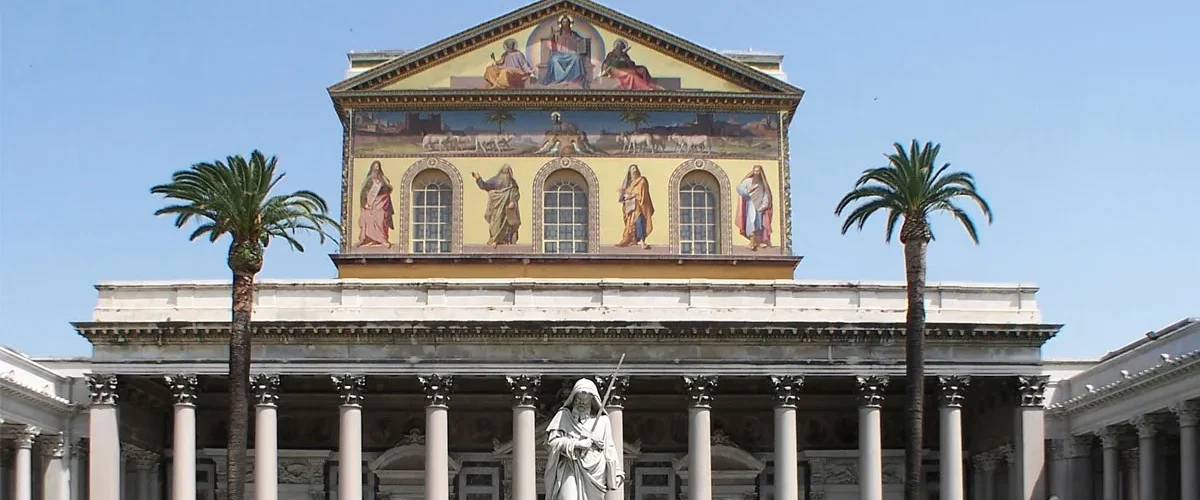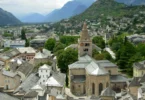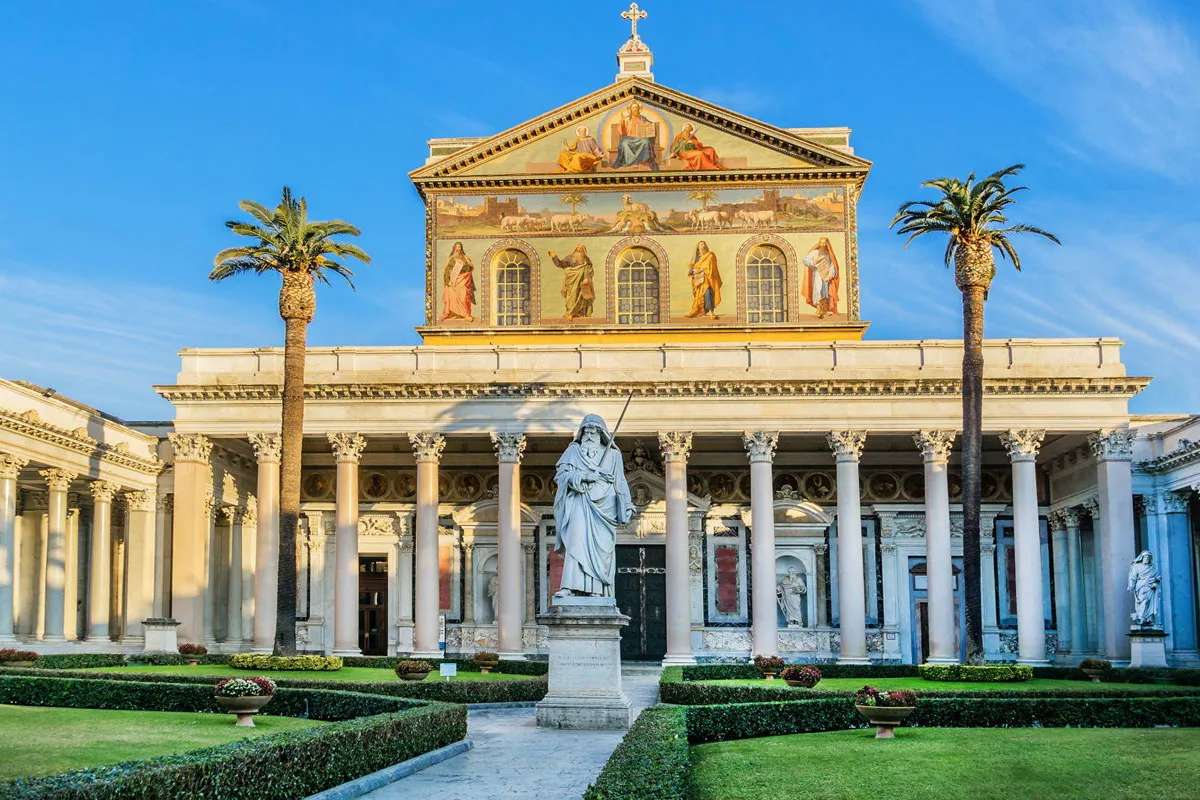
Introduction
The Papal Basilica of Saint Paul Outside the Walls (Italian: Basilica Papal di San Paolo fuori le Mura) is one of Rome’s four major papal basilicas, along with the basilicas of Saint John in the Lateran, Saint Peter’s, and Saint Mary Major, as well as one of the Seven Pilgrim Churches of Rome. The Basilica is in Italy, but the Holy See (a type of government for the Vatican) owns it. Italy agrees that the Holy See really owns it and gives it special protection like what foreign embassies get under international law.
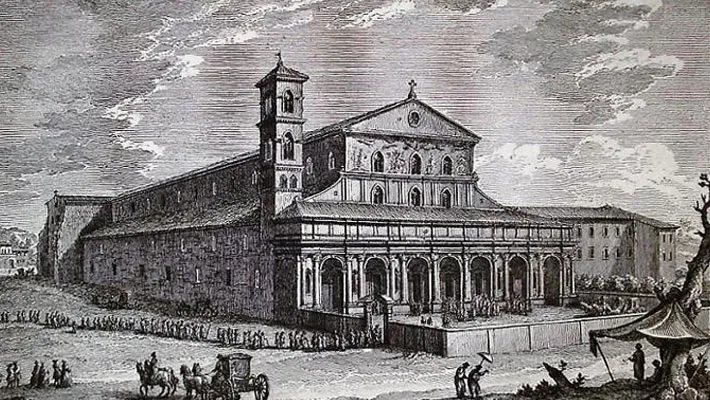
Emperor Constantine I started the first basilica on top of Paul of Tarsus’s resting place, where Paul’s followers had built a memorial after his death. Pope Sylvester dedicated it in 324.
Later, in 386, Emperor Theodosius I decided to build a bigger, more splendid basilica that had a main area and four side aisles, including a cross-shaped area. Around 402, Pope Innocent I likely dedicated it. Emperor Leo I completed it between 440 and 461, making it bigger than the Old Saint Peter’s Basilica at that time. The Christian writer Prudentius described its magnificence in his time, under Emperor Honorius.
Repairs were made under Emperor Leo I after a fire or lightning damaged it, especially around Saint Paul’s burial spot, where a new altar was set up. This might have been the first altar placed there, which Leo I did while also fixing other parts of the basilica and a fountain.
Pope Gregory the Great later made significant changes to the altar area, putting a new altar over the old one, right above Saint Paul’s tomb.
Two monasteries were nearby, one for men and one for women, with special clerics holding masses. Over time, these institutions declined until Pope Gregory II revitalized them.
An earthquake in 801 caused damage, but Leo III repaired it. Because it was outside Rome’s defensive walls, it suffered during a 9th-century attack but was fortified by Pope John VIII, creating a fortified village that lasted until another earthquake in 1348.
In 937, Odo of Cluny took charge, followed by involvement from Pope Gregory VII. Notably, a wealthy merchant donated bronze doors made by artists from Constantinople.
The monastery’s cloister was built between 1220 and 1241. The basilica served as the Latin Patriarch of Alexandria’s seat until 1964. Pope Benedict XIV restored many artworks, including a series of papal portraits.
A fire in 1823, possibly started by repair work, nearly destroyed the basilica, leading to its reconstruction. Despite intentions to rebuild it as it was, changes were made. Contributions for the rebuild came from around the world, including precious materials for the altar. The basilica was reopened and reconsecrated, with ongoing work into the 20th century. It became a national monument, but suffered from an explosion in 1891.
In 2005, Pope Benedict XVI placed the basilica under the care of an archpriest, appointing Archbishop Andrea Cordero Lanza di Montezemolo as the first to hold this position.

The entrance to the basilica is marked by a covered walkway from the 19th century, showcasing a blend of Neo-classicist style. To the right of this walkway is the Holy Door, which is specially opened for Jubilee years. Beyond this lies a second door, known as the Byzantine door, a holdover from before the 19th-century rebuild. Created in 1070 by Pantaleone of Amalfi, this door features 56 bronze panels with scenes from the lives of Christ and his apostles, believed to have been made in Constantinople.
The current structure keeps the original layout with a central nave flanked by four aisles, measuring over 430 feet in length and nearly 100 feet in height, making it the second-largest church in Rome.
The interior boasts 80 columns supporting a ceiling decorated with wood and stucco from the 1800s, while the ancient basilica is represented by parts of the apse and the triumphal arch. The apse’s mosaics suffered damage in the fire of 1823, with only fragments making it into the restoration. The triumphal arch’s 5th-century mosaics, although extensively restored, date back to the era of Leo I and feature imagery from the Apocalypse, surrounded by symbols of the Evangelists and figures of Saints Peter and Paul.
The basilica’s windows, which might seem like stained glass from inside, are actually made of translucent alabaster.
A notable piece from the 13th century, the ciborium over the altar by Arnolfo di Cambio, remains from the earlier building. Previously, popes were commemorated with portraits in a frieze along the nave; a 19th-century mosaic rendition now continues this tradition. The nave’s walls are adorned with painted scenes from the life of Saint Paul.
The cloister to the south, dating back to the early 1200s and crafted by Vassalletto, is praised for its medieval beauty. Its unique columns, adorned with mosaics of gold and colored glass, along with historical fragments from the older basilica, add to its charm.
Outside the basilica stands Timothy Schmalz’s sculpture “When I was in Prison,” part of a series installed across Rome for the Extraordinary Jubilee of Mercy, representing the church’s commitment to compassion and outreach..
Tomb of Saint Paul
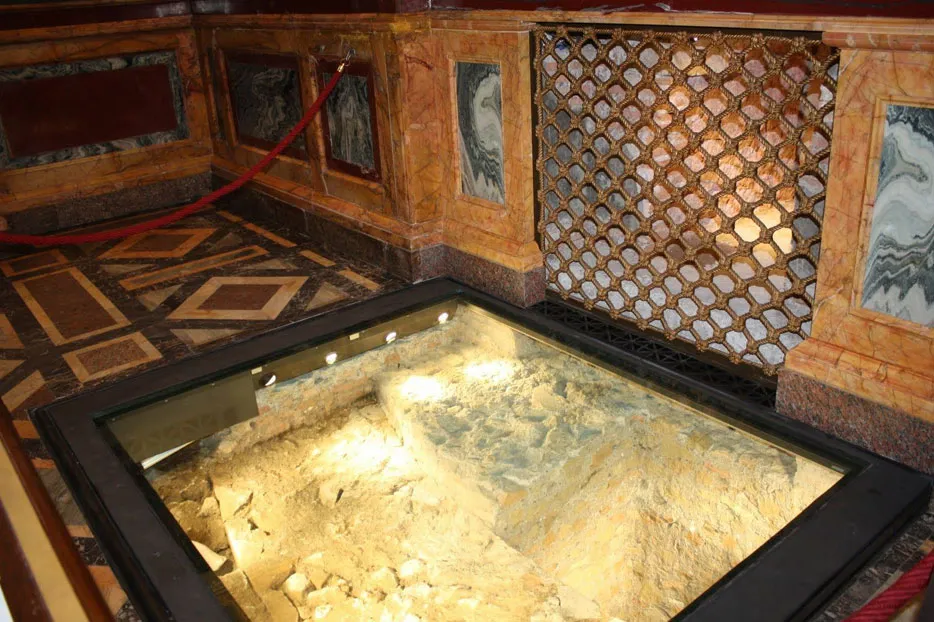
According to an old story, after Saint Paul was martyred, his body was laid to rest about two miles from where he died, in a burial place owned by a Christian lady named Lucina. This spot, marked by a memorial, quickly became special to many people.
Emperor Constantine built a church there, and later, Emperor Theodosius I made it much bigger around the year 386, creating what we now call Saint Paul Outside the Walls. In the 4th century, they moved Paul’s body, except for his head, under the church into a big stone coffin. (The church believes his head is kept at the Lateran.) Paul’s grave is right under the church’s altar, a little over 4 feet down. The grave marker has a Latin phrase meaning “to Paul the apostle and martyr” and has holes for pouring in sweet-smelling oils or other offerings according to old Roman customs. This coffin is pretty big, over 8 feet long and about 4 feet wide.
In 2006, the Vatican said they found a white marble coffin under the altar, which might be where Saint Paul is buried. They started looking for it in 2002 because visitors really wanted to see it, especially during the special Jubilee year in 2000. They didn’t move the coffin but could see one side of it. In 2009, the Pope shared that tests on the bones inside match the time Paul would have lived, which makes people think they really are his.
They also found a line of bricks that shows where the first church built by Constantine used to end, proving that the old church faced the opposite direction compared to the bigger church built later by Theodosius I.
The Prophecy of the monk Malachi
Malachi was a monk from Ireland who lived in the 12th century. About 400 years after he died, people found a paper he supposedly wrote. It listed all the future popes from his time, starting with Celestine II, with short but accurate descriptions. Malachi said there would be 111 more popes after Celestine. He believed that after the last pope on his list, the Church, and maybe even the world, would end.
Surprisingly, in the basilica, there are 111 spaces with pictures of the popes from Celestine onwards, and Pope Francis’ picture is in the last spot. But, this last picture is just at the end of a hallway, and around the corner, there are more empty spots for future popes. Also, many historians think the paper from Malachi might not be real. They suspect it could be a fake made in the 1500s.

Fire and reconstruction
In 1823, during roof repair work on the basilica, a worker accidentally left a fire unattended, which he had used for illumination. The fire quickly spread, engulfing the basilica in flames for hours and causing extensive damage. Miraculously, certain parts such as the triumphal arch, ciborium, apse mosaics, and cloister were spared.
The Roman Catholic community was deeply affected by this traumatic event, so much so that the seriously ill reigning pope was shielded from the news. His successor, Leo XIII, initiated the challenging and costly reconstruction effort, aiming to restore the basilica exactly as it was before.
A fundraising campaign was launched, drawing support from various monarchs including the Tsar of Russia, the Kings of France and the Netherlands, and the Viceroy of Egypt. Some monarchs contributed precious building materials like lapis lazuli for mosaics and alabaster columns. The new basilica was officially opened in 1854, although restoration work continued until 1930. In 2006, while renovating the floors, workers uncovered the sarcophagus of Saint Paul, now visible near the altar but beneath the basilica’s floor level.
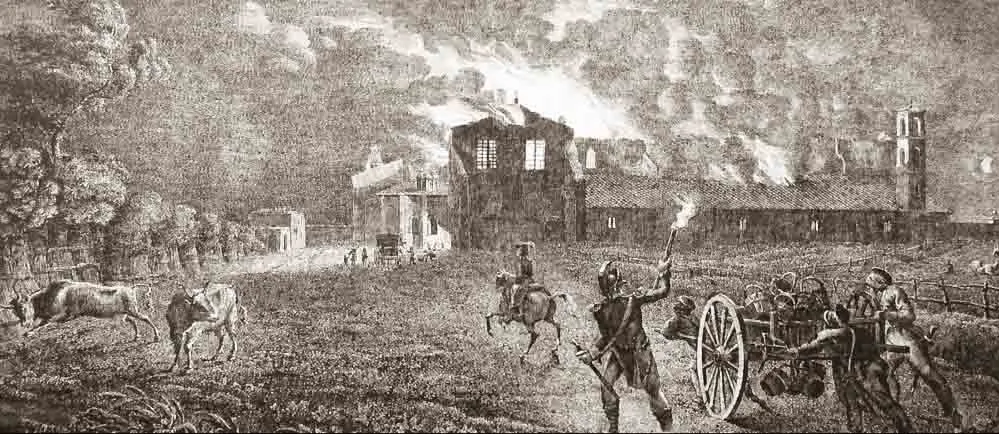
The archaeological site
Outside the church, there is an archaeological site unearthed in 2008. It contains the remnants of an ancient monastery for pilgrims, dating back to 600 A.D. Here, visitors can explore a gallery showcasing artifacts from the ancient basilica and artworks discovered during the excavations. Additionally, an art gallery displays paintings, wooden tables, sacred objects, and a valuable Bible from the Carolingian period (9th century).
Annual Feast Day
Feast Date : 5th January
The Annual Feast Day of the Saint Paul Outside the Walls Italy is Celebrated to 5th January every year.
Mass Timing
WEEKLY MASSES :
7:00 am, 8:00 am, 9:00 am, 10:30 am, 06:00 pm
WEEKEND MASSES :
Saturdar Day : 7:00 am, 8:00 am, 9:00 am, 10:30 am, 06:00 pm
Sunday : 7:00 am, 8:00 am, 9:00 am, 10:30 am, 12:00pm, 06:00 pm
Church Visiting Hours
Monday to sunday : 7:00 AM to 6:30 PM
Contact Info
Piazzale San Paolo,
1 – 00146,
Rome.
Phone No.
Phone: +39 06 698 80 800
Accomodations
Connectivities
Airway
The nearest major airports to The Papal Basilica of Saint Paul Outside the Walls are Ciampino Airport and Leonardo da Vinci (Fiumicino) Airport. Both airports offer the Leonardo Express or Pullman Terravision to Termini Station, where you can then follow the same directions for Metro Line “B” from Termini Station; the taxi ride from either airport takes approximately 40 minutes.
Railway
The nearest Metro to The Papal Basilica of Saint Paul Outside the Walls Italy is Garbatella. which is 2.4 km away from the Shrine.

